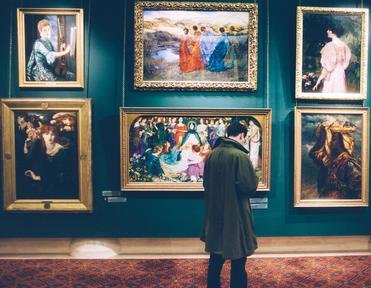Quiz Answer Key and Fun Facts
1. The original "Smithsonian" building is "the Castle" centered on the Mall. What is the name of the style (or type) of architecture that the building is designed in?
2. One of the many buildings of the Smithsonian is the Postal Museum, which has over 16 million philatelic items in its collection. One of the exhibits is the first postage stamps issued in America, in 1847. George Washington was on the ten-cent stamp. Who was featured on the five-cent one?
3. In 1962, the Smithsonian acquired the National Portrait Gallery and opened it to the public in 1968. The Gallery's most prized possession is a portrait of George Washington that was saved from being auctioned in 2001. Who painted this famous portrait, known as the "Lansdowne portrait"?
4. The National Museum of African Art, at 950 Independence Avenue SW, has many great examples of the art of the African continent, both ancient and modern. In 2000, one of the exhibits was titled "Oshogobo Art in the 1960s". In what African country is Oshogobo located?
5. At the Smithsonian's Cooper-Hewitt National Design Museum in New York City, you can see the works of this man, having the distinction of being the first person to successfully market his designs (furniture, silverware, etc.) using his famous name.
6. The Smithsonian American Art Museum is the home to the world's largest collection of American works- over 37,000. However, this historic building was not always a museum. What was it previously?
7. One of the most popular sites in the Smithsonian's collection is the National Zoological Park, or zoo. One of the exhibits in the Zoo is called Lemur Island, where you can see these primates that are indigenous to what country?
8. One of the biggest conservation programs at the National Zoo is the Golden Lion Tamarin program. What are Golden Lion Tamarins?
9. In the Arthur M. Sackler Gallery and Freer Gallery of Art, which featues many works of Asian art, you can find changing exhibits on different types of art. One 1999 exhibit featured art dedicated to this six-handed Indian Great Goddess.
10. Which of the Smithsonian's buildings was constructed in 1881 for the purpose of housing exhibit materials acquired from the nation's Centennial Exposition at Philadelphia?
11. The most popular of the Smithsonian's museums is the National Air and Space Museum, or NASM. One of this museum's exhibits, "Milestones of Flight", displays aircraft that featured in some historic first. What is the claim to fame of the Bell X-1 aircraft Glamouous Glennis?
12. One of the exhibits in the National Air and Space Museum, "Explore the Universe", features ways in which people have attempted to explain the heavens since the dawn of time. Among the instruments on display is a Tycho Armillary Sphere. For what was this used?
13. In the "Exploring the Planets" exhibit of the National Air and Space Museum, you can see Vikings 1 and 2, craft designed to study what celestial body?
14. Harry Winston donated this object to the National Museum of Natural History; today it's probably the most famous item in residence.
15. In the National Museum of Natural History's exhibit called "Textiles of the North American Southwest", you can see many fine examples of Mexican cobijas, which are
16. The National Museum of Natural History boasts the world's largest collection of foraminifera. What are Foraminifera?
17. One of many interesting items you can see in the National Museum of American History is one of these, made by Antonio Stradivari in Italy in 1701.
18. One of the most popular exhibits in the National Museum of American History is "The American Presidency", which features many artifacts reflecting the holders of the nation's highest office. One of the items you can see is a model log cabin on a pole, carried by supporters of this President in his "log cabin" campaign.
19. What American chef gave her entire kitchen to the National Museum of American History in November 2001?
20. In the National Museum of American History, you can see an exhibit titled "Electricity" that traces the invention of the light bulb and the development of electricity in America. Here you will learn that the world's first large-scale central generating station opened at this place in 1895.
Source: Author
bullymom
This quiz was reviewed by FunTrivia editor
thejazzkickazz before going online.
Any errors found in FunTrivia content are routinely corrected through our feedback system.


